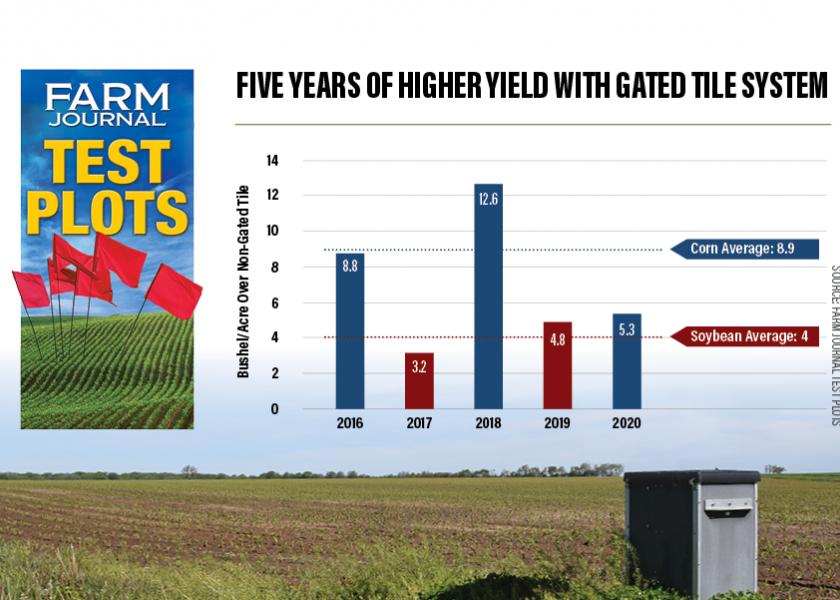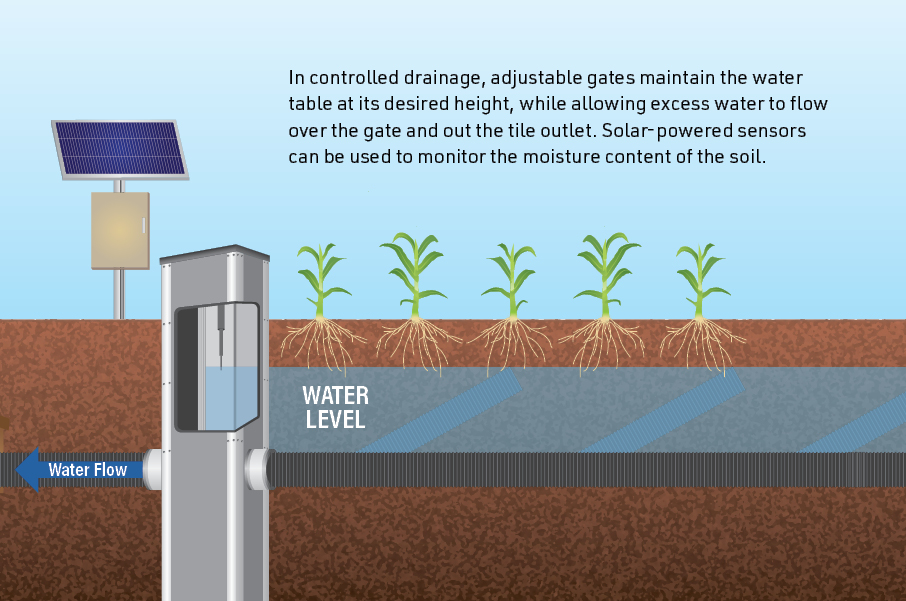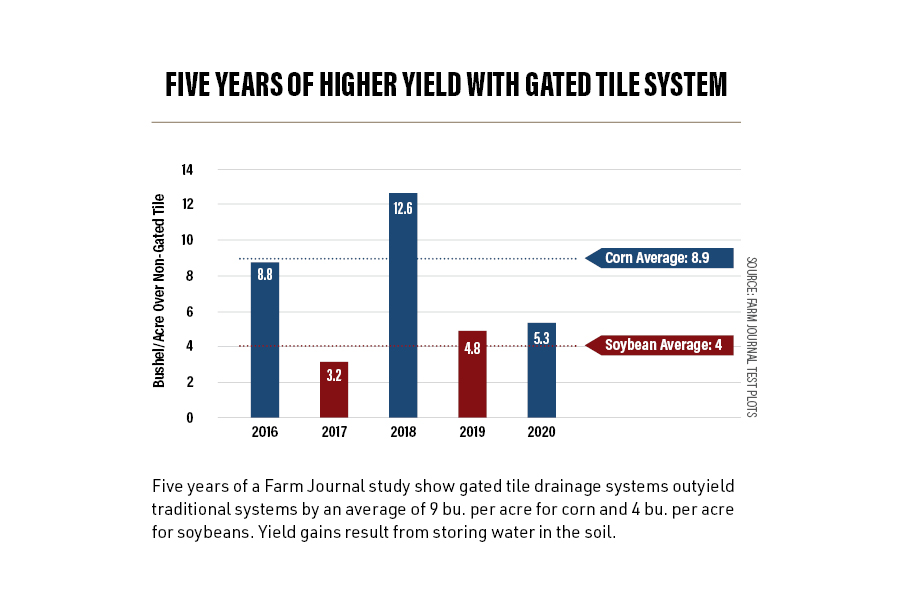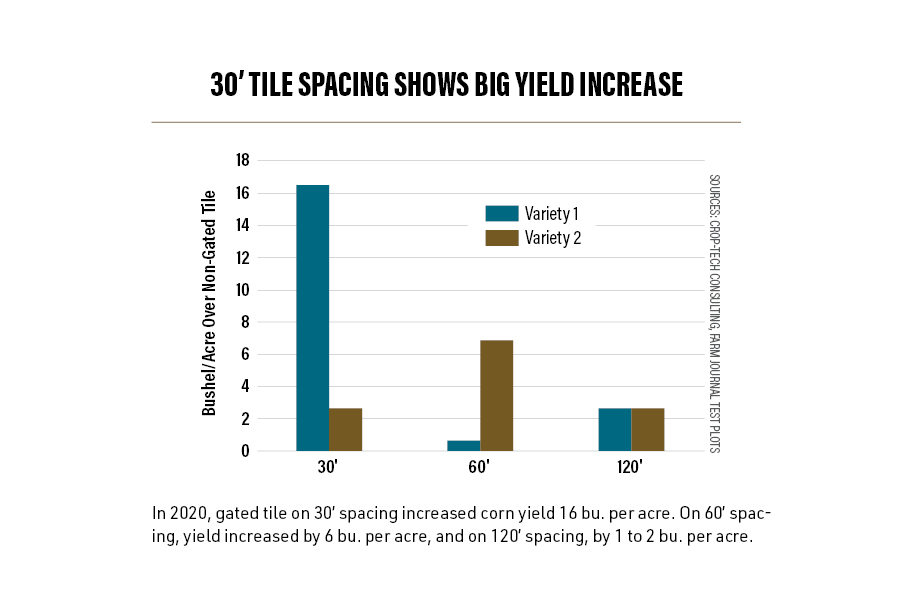Farm Journal Test Plots: How to Profit From A Changing Climate

Who would have guessed there’s a bright side to climate change, at least for some farmers? A long-term Farm Journal study suggests Midwestern crop producers can turn today’s more extreme weather patterns into more bushels per acre. It involves managing drainage water, explains Farm Journal Field Agronomists Ken and Isaac Ferrie.
The outlook: Warmer, more rain, more big storms
If you’ve noticed more volatile weather on your farm, you’re not alone. Analysis by Eric Snodgrass, principal atmospheric scientist at Nutrien Ag Solutions, shows these trends for the Midwest:
- Over the past 50 years temperatures have increased by an average of 1˚F.
- Nighttime low temperatures have increased by 2˚F.
- Frost-free days have increased by six to nine days per year, all occurring in April (so the last frost comes earlier).
- Rainfall has increased by 5½" per year.
- Rainfall events of 2" in 24 hours occur twice as often in Illinois and three times as often in Iowa.
- Despite nine more frost-free days in Illinois, the additional rainfall has reduced the number of
- planting days in April and May by five days, compared with 1980.
- The average minimum temperature in Illinois has increased by 3˚F since 1970.
- Relative humidity has increased by 6%.
What a changing climate means for farmers
“Climate change isn’t all bad,” Ken says. “In fact, it’s good for corn and soybean growers in the Midwest and Canada. More water and a longer growing season translate into more bushels of grain.”
But, he says, farmers must learn to farm around the negative aspects: fewer days to do spring fieldwork and more frequent heavy rain events.
“A well-designed controlled drainage system can move a lot of water in a short time, when necessary, while storing some of that water for use later in the season,” Ken says.
How to gain planting days
The farm-scale Farm Journal drainage study has been underway since 2002. Installing tile drainage in poorly drained soil increased corn yield by 7 bu. to 12 bu. per acre (and by 60 bu. per acre in one extremely wet part of the study field).
Since 2016, the study has included controlled drainage, in which adjustable gates are used to maintain the water table at the desired height, while allowing excess water to exit normally through the tile outlet. Water remains available, but crop roots don’t get saturated.
The study also showed installing a traditional tile drainage system increased the number of days available for field work during a 48-day period in April and May.
With no tile, only four days were fit to work. Tile increased that to 16 days with lines on 120' spacing, 22 days with 60' spacing and 38 days with 30' spacing.
How gated tile systems boost yield
“Almost every year — not just drought years — we run short of water sometime in the growing season,” Isaac notes. “If a gated tile system lets us hold back just 1" or 2" of water in July or August, we might be able to improve ear fill.”
If soil contains lots of macro- and micropores and/or surface cracks, rain rushes straight to the tile line and escapes. “In multiple rain events in July, the gated side of the field gained 0.1" to 0.15" more useable water in the top foot of soil per rain event,” Isaac says. “When there were four rain events over two weeks, we saved 0.3" to 0.5" more useable water in the top 1' of soil. That’s where we want our useable water because that’s where the soil nutrient load is highest. And this doesn’t include the water we gained deeper in the soil profile.”
A gated system does not simply shut off drainage; it just holds the water table to the desired level, Isaac explains.

“On one occasion, we got 2" of rain, but we did not saturate the root zone,” he says. “When water rose above the gates, it flowed out through the tile lines.”
One year, after a 2" August rain, water began flowing from ungated tile lines in a few hours. On the gated side of the field, the lines never flowed. “By holding back the water, the soil was able to reabsorb it,” Ken says. “That 2" of water, at that point in the season, could add a lot of bushels.”
In 2020, gated tile on 30' spacing increased corn yield about 16 bu. per acre, compared with non-gated tile; on 60' spacing, about 6 bu.; and on 120' spacing, 1 bu. to 2 bu.
Over five years and across all tile spacings, gated systems averaged about 9 bu. per acre more for corn and 4 bu. per acre for soybeans.
Overall, gated tile lines on 30' spacing have performed best in the study. “But we are seeing a yield boost from all spacings (on top of what we gained from the tile itself),” Isaac says. “During the five years, gated 30' spacing is returning about 12 bu. per acre on corn and 6.8 bu. per acre on soybeans.”
Gated systems save fertilizer
“Slowing water’s departure from the field gives soil more time to capture the water, leading to less nutrient loss,” Isaac says. “Depending on spacing, we’ve observed a 20% to 40% reduction in nutrient loss with controlled drainage during large rain events.”
A new role for tile systems
“These results suggest we need to change our strategy from merely getting water out of the field quickly to actively managing that water,” Ken concludes. “That can help us not merely cope with climate change, but actually see benefits from it. Fortunately, controlled-drainage technology is continuing to improve.”



Thank You to Our Test Plot Partners
Agri Drain Corporation; GroGuru; Kinze Manufacturing; Lance Landford, AgriMeasures; McLaughlin-Dooley Farms; Prinsco; Unverferth Manufacturing Company; Sentek Sensor Technologies; Williamson Farm Drainage
Farm Journal Test Plots Pledge
You can count on our test plots to be conducted on real farms with real equipment using a high-touch set of protocols. The information will be completely independent and actionable. Our hands will always be in the dirt researching the production practices and technology that are best for you.
To learn more, visit AgWeb.com/FJ-test-plots







